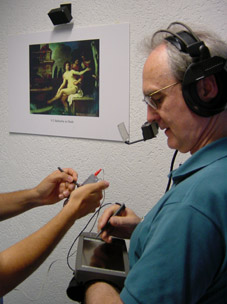
|
|
ERCIM News No.46, July 2001 [contents]
|
by Reinhard Oppermann
In Nomadic Computing, mobile users are supported by contextualised information presentation and interaction. At the GMD Institute for Applied Information Technology, prototypes and services are currently being developed in the framework of two projects: ‘Crumpet’, a European project with five partners, focuses on localisation of the user and personalisation of information; ‘SAiMotion’, a co-operation between GMD and Fraunhofer Gesellschaft, concentrates on context modelling and Human-Computer Interaction.
Human-Computer Interaction is one of the key issues for information systems in general, and for nomadic information systems in particular. Since information technology is used as a means for accomplishing tasks, when information processing is embedded into a more general frame of tasks, and computing technology is embedded into other equipment and technical infrastructure, Human-Computer Interaction is of central value for effectiveness, efficiency and user satisfaction. This is particularly true as mobile information and communication devices become smaller and more restricted with respect to information presentation, data entry and dialogue control. Mobile information and communication devices, like PDAs or cellular phones, are currently designed for dedicated tasks, but their application is becoming more and more integrated into a task flow where stationary and mobile devices are used together.
Nomadic computing starts with this state of technology, in which the activities of a user can be supported during the whole process of task accomplishment independently of specific devices, and access can be provided to public and personal information spaces. Nomadic Computing focuses on activities distributed in space (people roaming around), time (people with several overlapping tasks) and social communities (involving several people). Nomadic information systems allow the user to prepare an activity from home using the desktop, by browsing through and editing notes and messages in the public (the Web), corporate (business data) and personal information spaces (address book and personal papers). On tour, the ongoing activity is supported by a mobile device, and back at home or in the office the preferred device will again be the desktop computer. Continuous access to information spaces is provided via the Internet, wired or wirelessly.
 |
| Current pen based interaction. |
The Human-Computer Interaction challenge comprises two classes of requirements. Firstly, interaction must be consistent from one device to another, using non-contradictory metaphors and methods. Secondly, interaction has to be appropriate for the particular device and environment in which the system is used. Note that the requirement does not call for identical metaphors and methods. The desktop computer allows for different interaction techniques than a palmtop computer or a WAP phone. Using the keyboard and a mouse may be the method of choice for the desktop, while using the pen and the microphone may be appropriate for the palmtop. The predominance of visual display and mechanical input with the desktop will be replaced by the audio display and speech control with the palmtop.
Crumpet and SAiMotion
In the projects Crumpet and SAiMotion we develop scenarios and prototypes for indirect interaction by exploiting the user’s navigation in the physical space and providing easy and intuitive interaction methods. By roaming in the physical space the user indicates environments of interest and objects of relevance for current tasks. Tourist and mobile business applications are selected to demonstrate contextualised content selection and new interaction paradigms. Users are supported by logistic services in finding transport, shopping or accommodation services, partners or places for business, and scalable explanations of objects related to the interests and previous knowledge of the user. The implementation will be based on a standards-compliant framework, extended to support nomadic applications, devices, and networks for fast creation of robust, scalable, seamlessly accessible nomadic services. In particular the following services are foreseen:
Other research and development activities are planned to find and disseminate solutions for new types of devices, infrastructure and services which will increase the benefit for a wide range of users. Several partners are involved in these activities, including FhG Fraunhofer-Institut f¸r Graphische Datenverarbeitung IGD), Fraunhofer-Institut f¸r Arbeitswirtschaft und Organisation (IAO), Fraunhofer Institut f¸r Zuverl”ssigkeit und Mikrointegration (IZM), Fraunhofer Institut f¸r Integrierte Schaltungen (IIS); GMD Institut f¸r Publikations- und Informationssysteme (IPSI); Emorphia (UK), University of Helsinki, Sonera Ltd (Fi), Queen Mary & Westfield College London, European Media Laboratory GmbH (D), Portugal Telecom InovaÁ“o, S.A.
Links:
http://fit.gmd.de/topics/icon/
http://fit.gmd.de/projects/crumpet/
http://fit.gmd.de/projects/saimotion/
Please contact:
Reinhard Oppermann — GMD
Tel: +49 2241 14 2703
E-mail: Oppermann@gmd.de